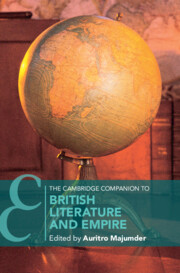Refine search
Actions for selected content:
190 results
Chapter 1 - Truth in Fiction
-
- Book:
- Truth and Reference in the Making of Fiction
- Print publication:
- 22 January 2026, pp 14-34
-
- Chapter
- Export citation
Chapter 4 - Fictive Imaginings as Entertainings
-
- Book:
- Truth and Reference in the Making of Fiction
- Print publication:
- 22 January 2026, pp 75-92
-
- Chapter
- Export citation
Chapter 9 - Fictional Characters and Fictional Reference
-
- Book:
- Truth and Reference in the Making of Fiction
- Print publication:
- 22 January 2026, pp 182-196
-
- Chapter
- Export citation
Chapter 6 - Fictional Narrators
-
- Book:
- Truth and Reference in the Making of Fiction
- Print publication:
- 22 January 2026, pp 111-130
-
- Chapter
- Export citation
Chapter 5 - Desires and Emotions in Response to Fiction
-
- Book:
- Truth and Reference in the Making of Fiction
- Print publication:
- 22 January 2026, pp 93-110
-
- Chapter
- Export citation
4 - Invented Situations
- from Part I - Relationships
-
- Book:
- The Epistles of John
- Published online:
- 17 December 2025
- Print publication:
- 08 January 2026, pp 95-110
-
- Chapter
- Export citation

The Epistles of John
- Origins, Authorship, Purpose
-
- Published online:
- 17 December 2025
- Print publication:
- 08 January 2026
Chapter 4 - From Perception to Imagination
-
- Book:
- Kant and the Power of Perception
- Published online:
- 27 November 2025
- Print publication:
- 11 December 2025, pp 126-160
-
- Chapter
- Export citation

The Cambridge Companion to British Literature and Empire
-
- Published online:
- 20 November 2025
- Print publication:
- 04 December 2025
Chapter 11 - Feminisms in African Literature
- from Part II - Theoretical Turn
-
-
- Book:
- African Literature in Transition
- Published online:
- 07 November 2025
- Print publication:
- 20 November 2025, pp 203-219
-
- Chapter
- Export citation
Chapter 9 - Print Culture and New Fictional Imagination in Colonial Egypt
- from Part II - Readers and Audiences
-
-
- Book:
- African Literature in Transition
- Published online:
- 23 October 2025
- Print publication:
- 06 November 2025, pp 184-201
-
- Chapter
- Export citation
Chapter 4 - Bloomsbury and the New Biography
- from Part I - Aesthetic Bloomsbury
-
-
- Book:
- A History of the Bloomsbury Group
- Published online:
- 09 October 2025
- Print publication:
- 23 October 2025, pp 52-67
-
- Chapter
- Export citation
2 - Literary Form
- from Part I - First Principles: What Is a Gospel, According to Origen?
-
- Book:
- The Life of Jesus in the Writings of Origen of Alexandria
- Published online:
- 26 September 2025
- Print publication:
- 16 October 2025, pp 17-37
-
- Chapter
- Export citation
4 - Between the Rivers Jordan and Chebar
- from Part II - A Sign for This Generation: Reading the Gospels with Origen
-
- Book:
- The Life of Jesus in the Writings of Origen of Alexandria
- Published online:
- 26 September 2025
- Print publication:
- 16 October 2025, pp 71-91
-
- Chapter
- Export citation
Chapter 13 - Kantian Strains in Stages on Life’s Way
- from Part III - Kierkegaard and the Concept of Thought Experiment
-
- Book:
- Kierkegaard and the Structure of Imagination
- Published online:
- 26 September 2025
- Print publication:
- 16 October 2025, pp 214-229
-
- Chapter
- Export citation
Chapter 3 - Fossil Fuels and the Fiction of Extraction
- from Part I - Origins
-
-
- Book:
- Commodities and Literature
- Published online:
- 14 October 2025
- Print publication:
- 09 October 2025, pp 61-75
-
- Chapter
- Export citation
7 - Remedial Relief
-
-
- Book:
- Relief in Greek, Roman, and Late Antique Art
- Published online:
- 11 October 2025
- Print publication:
- 25 September 2025, pp 232-258
-
- Chapter
- Export citation
Conclusion
-
- Book:
- Maritime Relations
- Published online:
- 23 August 2025
- Print publication:
- 04 September 2025, pp 182-186
-
- Chapter
- Export citation
Introduction
-
- Book:
- Railway Infrastructure and the Victorian Novel
- Published online:
- 12 August 2025
- Print publication:
- 28 August 2025, pp 1-23
-
- Chapter
-
- You have access
- HTML
- Export citation
Chapter 4 - The Geographies of British Postmodern Fiction
-
-
- Book:
- The Cambridge Companion to British Postmodern Fiction
- Published online:
- 07 August 2025
- Print publication:
- 21 August 2025, pp 66-81
-
- Chapter
- Export citation
